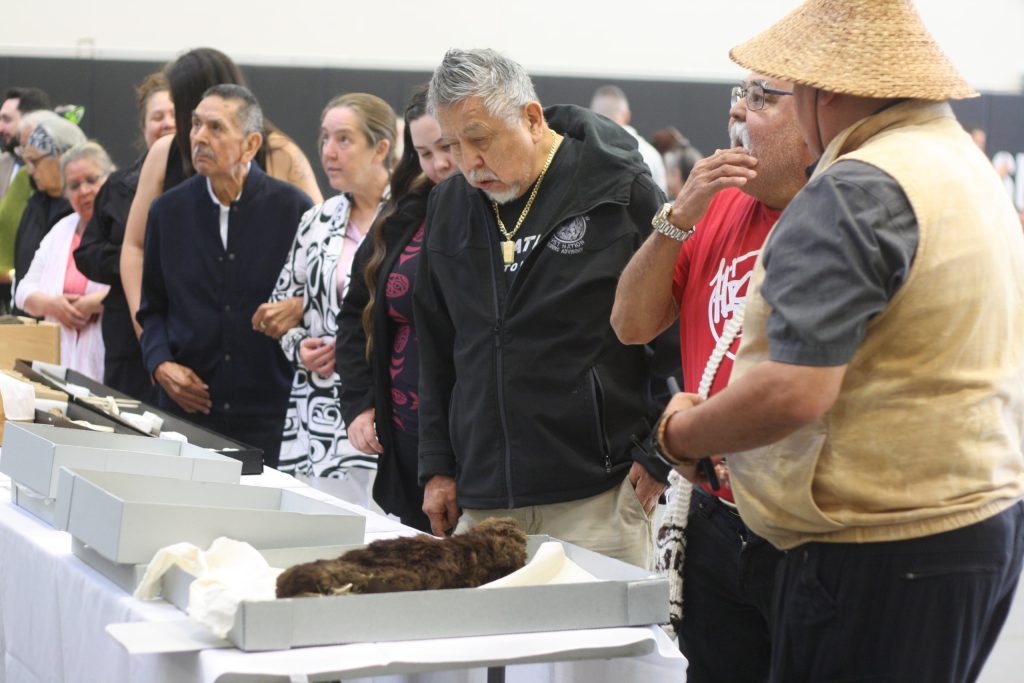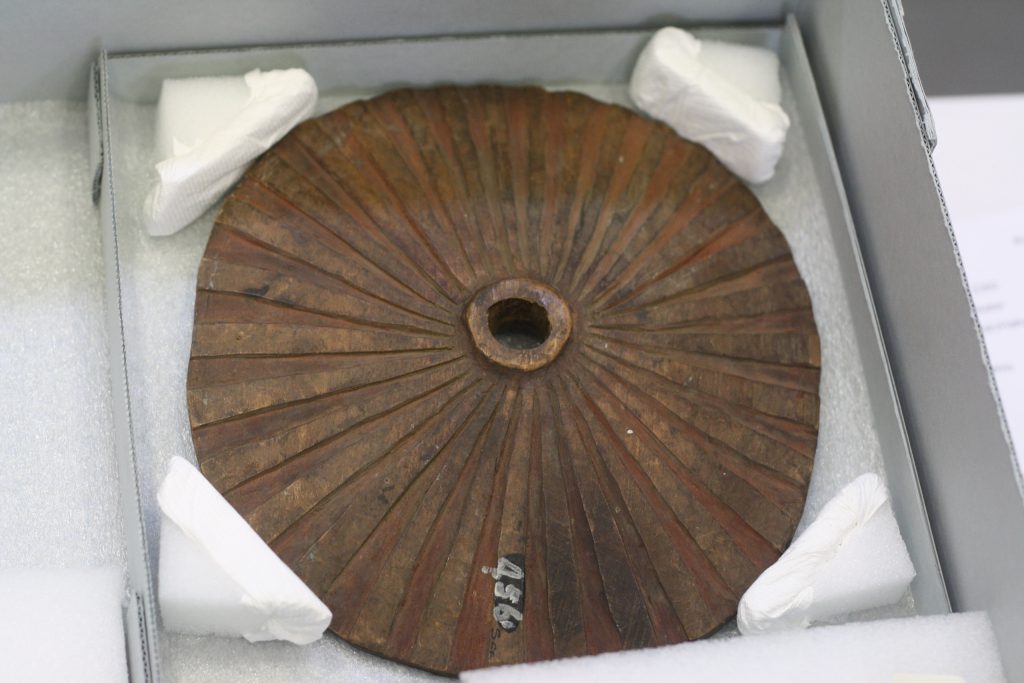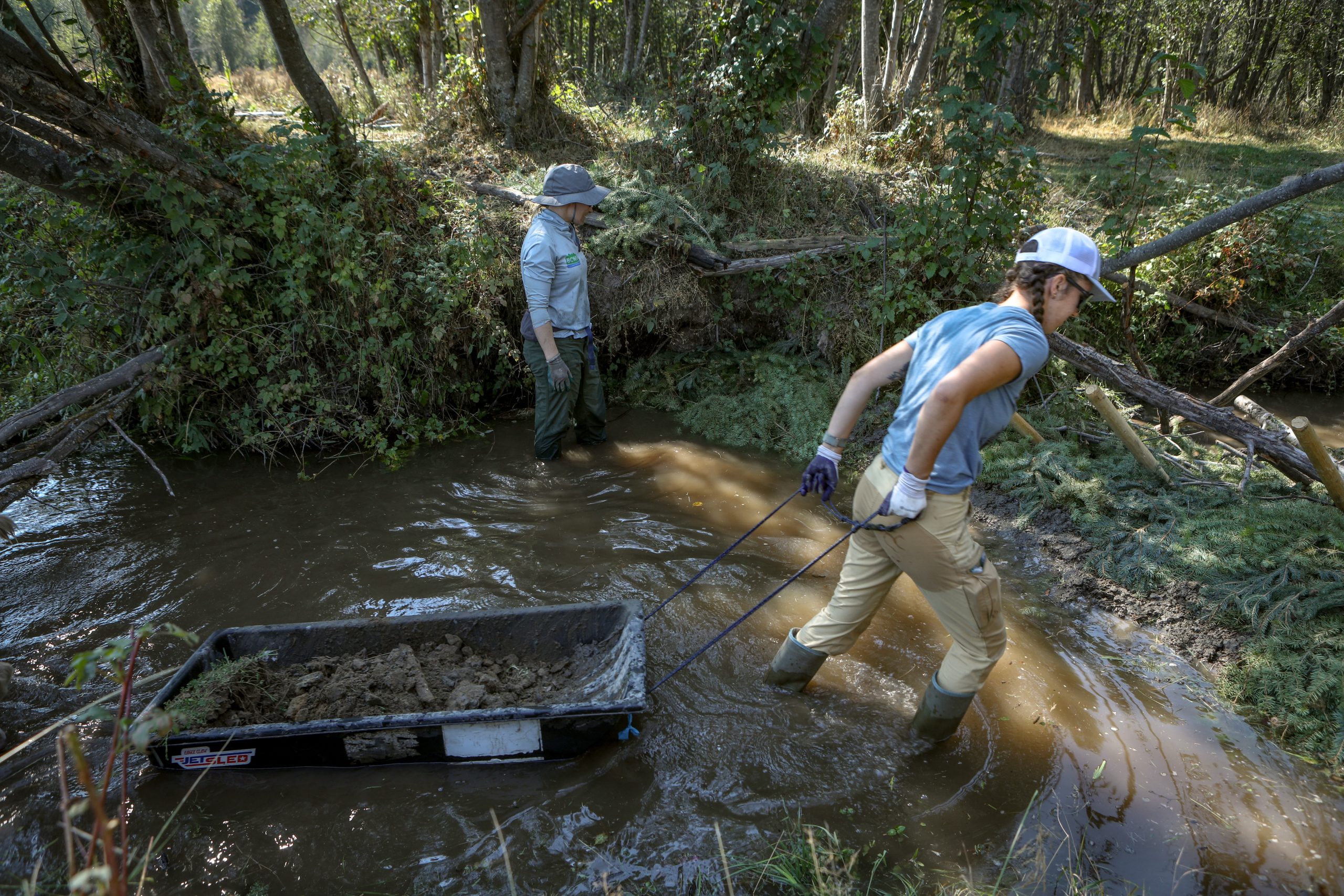Dozens of cultural belongings returned to Snuneymuxw from Royal BC Museum: ‘It’s been a long time coming’
Leaders hope the repatriation of these items — including a beetle pendant, carved stone bowls and more — will be the first of many from around the world


On a long table at the back of Snuneymuxw First Nation (SFN)’s Recreation and Wellness Centre gym, dozens of sacred cultural artifacts were laid out in boxes for community members to view.
On May 23, the nation held a ceremony to welcome the items home after the Royal BC Museum in “Victoria” returned nearly 100 items from its collection that included stone bowls and hand mauls, a herring drying stick, a spindle whorl and wool carding and berry picking implements and were sourced from a number of locations throughout Snuneymuxw territory.
Media were invited to view and photograph some of the objects after the community members had gone through.
One item in particular immediately stood out — a shiny black pendant nestled in a box, situated among other jewellery-type cultural artifacts carved from stone and bone.
Just over seven centimetres long and about four and a half centimetres wide, the pendant is a stylized beetle in an oval shape, with large round eyes and a hole carved in the top for hanging. Though it has an obsidian-like appearance, it is carved from coal.
I know this because the pendant was described to me in detail by local Coast Salish artist and storyteller Eliot White-Hill, Kwulasultun from SFN, when I attended his master of fine arts thesis exhibit in April of last year.

In disbelief, I looked around the gymnasium to see if Eliot was there, and spotted him at one of the tables set out for community members to eat lunch.
“Eliot, the beetle pendant — am I crazy or is that the one you told me about?” I said, a little breathless, my mind reeling.
He nodded and said he was “stunned.” He had no idea the pendant was part of the Royal BC Museum’s collection, nor that it was within the group of objects to be returned to the nation that day.
Eliot had just returned that day from a research trip for the Museum of Archaeology and Anthropology at the University of Cambridge in preparation for a show that will open there in December. After hearing the news of the repatriation on social media, he scrambled for an earlier ferry so he could attend.
The reason the pendant is so striking is that its presence and image was one of the central themes within Eliot’s exhibit and master’s thesis, What is Sacred: Revitalizing Coast Salish Art and Culture.
One of the pieces he exhibited last year is the digital collage, “Not a single Snuneymuxw name,” which utilizes an image of the beetle pendant from the cover of the Royal BC Museum’s 1986 archaeological report, Senewélets: culture history of the Nanaimo Coast Salish and the False Narrows Midden.
In Eliot’s piece, he removes the image of the pendant and replaces it with the repeating title phrase, which references the fact that the report attempts to speak to the meaning and value of Snuneymuxw culture and artifacts but neglects to include or cite a single Snuneymuxw member, Elder or knowledge-keeper.

The report gives details from an archaeological dig that took place on “Gabriola Island” between 1966 and 1967 of a burial site in the False Narrows area. This pendant was removed from the grave site of an adolescent man who was elaborately adorned in a manner that suggested high status, wrote author David Burley, a professor of archaeology at Simon Fraser University.
Visually, the pendant is a remarkable piece of art, said Eliot.
“This ‘beetle pendant’ is one of my favourite instances of Coast Salish art to ever exist. It is so unique and strange relative to most Coast Salish objects of this era,” he wrote in his thesis. “That it depicts an insect is incredibly unique. Our art historically was often used to depict beings who have been spiritual helpers to Individuals.”
That said, he recognizes that repatriation is an incredibly complex and fraught topic with many layers. As a young Snuneymuwx member trying to understand his own history and culture, these objects are entangled with the post-colonial effort to reconnect and reckon with who they are, he said.
“I felt so conflicted, seeing it there in public. That was when it dawned on me, that the entire table was likely all objects that were from grave sites, which is really intense energy,” said Eliot.
“The big thing is that these objects and belongings do not belong in museums. I’ve spent the last few months now traveling around the world looking at museum collections and I’m kind of still processing all of that.
“But everywhere I went, I’ve found objects and belongings that my ancestors in Snuneymuxw made. And for whatever reason, they’re sitting on collections shelves in warehouses at these different museums around the world. Many of them are not even on display, some are on display that shouldn’t be, and all are so decontextualized, and so disrespected. So the work of bringing them home is really important.”

As a central force behind the revitalization of the Snuneymuxw style of carving, artist William Good had to look abroad to research his own community’s art form, finding examples in museums and archives in “Canada” and the “U.S.” and requesting photos and facsimiles of artifacts. It’s been a lifetime art revitalization project that has included consultations with Elders, scrutiny of historical pieces and and cross-comparison with stories he had grown up with.
When the Good family traveled to visit the Field Museum in “Chicago” last summer, they saw a number of Coast Salish items there, including some from Snuneymuxw, which came with mixed feelings, says Aunalee Boyd-Good, who along with her sister Sophia Good is one of the designers and directors of Ay Lelum The Good House of Design.
The ethics of museums and galleries housing artifacts, sacred cultural objects and even the human remains stolen, “donated” or bought under dubious circumstances from First Nations communities and private collectors and the ethics of when and how to repatriate those items is the subject of increasing scrutiny over recent years.
Earlier this month, IndigiNews publisher Eden Fineday wrote two powerful pieces about the discovery that her great-great-grandfather’s remains are housed in a Smithsonian storage facility, after his grave was ransacked by an army surgeon named Charles E. Woodruff.
A feature story about the return of a stolen Nisg̱a’a totem pole from a Scottish museum by IndigiNews editor Cara McKenna and The Narwhal reporter Matt Simmons looked at how the rematriation of such items could offer a template for the return of Indigenous belongings, and won a 2024 National Newspaper Award.
The future of the items repatriated to Snuneymuxw still needs to be worked out, and their return has been “a long time coming,” said Snuneymuxw Elder Geraldine Manson, who was at the event on May 23.
“It’s been many many years, and we talked about repatriation when I was on council in the year 2000, we started looking into doing repatriation then. We have a mask over in New York that needs to come home.
“What other objects are out there? These objects from the Royal BC Museum — this is only part of it. There are other objects from that museum that need to come home too,” she said. “It’s a beginning. I’m grateful for our leadership to clear the path to make this happen.”

Chief Michael Wyse (Xumtilum) has made repatriation a priority for 2024, and leadership has partnered with the Nanaimo Museum to identify Snuneymuxw sacred objects in different museums across the world and officially request their return, according to a statement from the First Nation’s media spokesperson.
When Snuneymuxw made a request to the Royal BC Museum in January, they heard back within a couple of weeks.
“Times have changed when it comes to repatriation,” said a statement from the First Nation, which plans to find homes for the repatriated objects within its buildings so they can be experienced by community members. “Some will be on display and some will be stored more privately. Our ultimate plan is to create a presentation space and cultural centre where our sacred objects can be homed.”
Author
Latest Stories
-
‘Bring her home’: How Buffalo Woman was identified as Ashlee Shingoose
The Anishininew mother as been missing since 2022 — now, her family is one step closer to bringing her home as the Province of Manitoba vows to search for her
-
‘NDN Giver’ exhibition showcases the art — and responsibility — of potlatching
From mugs to prints, masks and blankets, a new Bill Reid Gallery display celebrates the ancient Northwest Coast gift-giving tradition












